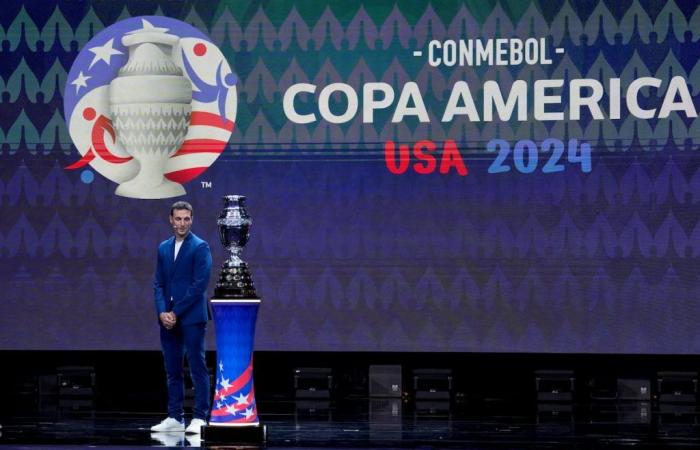The bass drum booms. The bar sings in the stands. “Olé, olá, I love you more every day.” It could be the stands of any stadium in Argentina. Or in Colombia. Or Mexico. But not. Those who sing these words that can be heard in the mouths of countless fans throughout the continent are the members of La12deAtlanta. It is the main Latin bar of Atlanta United FC, a decade-old team that has played in the American professional soccer league, the MLS, since 2017. The between 400 and 800 members travel behind the team — accompanied by their drums, trumpets and huge flags—throughout the North American country, within the logistical possibilities of such an extensive geography, spreading Latin American soccer passion throughout the territory.
They are not an exception. “All teams in the United States have their Latin bars because there are Latinos everywhere,” says the president and founder of la12, Gabriel Díaz, a 35-year-old Uruguayan who has been in the capital of Georgia for 20 years and celebrates part of his very identity. with every shout of goal. The thousands and thousands of fans like Díaz are the fertilizer for the late growth of the most popular sport in the world in the United States: here they no longer say “soccer”, it is said “football”.
Latinos are born with a ball in their cribs and grow up kicking balls on synthetic grass fields, dusty parks, and the asphalt of the streets in front of their homes. 73% of Latinos over 16 say they are sports fans, 32% inherited a love for a particular emblem and 22% consider themselves a “super-fan.” For thousands of them it is an important part of who they are. It is natural that they seek to replicate the tradition that they themselves or previous generations left behind.
It is something that was not always possible. Until 1996, when the first MLS season was played with ten teams, there was no professional soccer league in the country. It is true that there was a failed experiment between 1968 and 1984 that dressed Pelé and Beckenbauer in the New York Cosmos jersey. But the project never had a future in a country where baseball, American football and basketball absolutely dominated the sporting interests of the population. According to a Gallup poll, in 1997 the soccer it was tied for last on the list of favorite sports along with figure skating. Twenty years later it had risen to fourth place, very close to surpassing baseball.
There is no definitive data in this regard, but the correlation of the growth of the Latino population, and also its assimilation and greater cultural participation in the country, with the increase in the popularity of soccer does not leave too many doubts either. It can be seen in the selection of cities to host MLS teams, which with the debut of a new team in the border city of San Diego in 2025 reaches 30 clubs. When that happens, only between California, Texas and Florida (the States with the largest Latino population) they will have nine teams, almost a third of the entire league; New York, the other major Latin focus in the country, has two teams.
The Latinization of soccer is also contagious: 90% of Latino fans prefer to watch broadcasts in Spanish, but 65% of non-Latino white fans do too. And more and more people are seeing them. According to data from Forbes, the Qatar World Cup final was watched by 26 million people in the United States and the national team’s matches in the group stage had between 12 and 15 million viewers. As a comparison, the first game of this year’s NBA Finals was watched by an average of 11 million people. In the MLS the numbers are not close, but they already regularly exceed one million and the current record is held by the 2022 MLS Cup final, which had more than two million viewers.
A gold mine to be exploited
Seen with optimistic—and speculative—eyes, these data yield a positive conclusion: the margin for growth is still enormous and so are the potential profits. The Latino population alone is an immense market that has not yet been fully exploited. At this moment they move around 3.4 trillion dollars annually and the increase in their purchasing power is double that of other demographic groups. Furthermore, as a collective they spend an average of 20% more of their income on sports products and experiences.
In this context, the fact that the country has won the privilege of hosting an expanded edition of the Copa América this summer and, together with Mexico and Canada, an unprecedented 48-team world cup in 2026, can be seen more clearly. as a shrewd investment. Predictably, it will generate record profits and will serve as gasoline to spread the football fire in the country. The investments of American banks in large European clubs respond to the same reading of the football market. Another figure to support this idea: some 200 million people around the world watched the Super Bowl this year; The Clásico – between Real Madrid and Barcelona – is watched by more than 600 million every year and even so the American football final generates more money.
Maybe that’s why Inter Miami tried so hard—to the point of changing the league’s rules—to bring in Lionel Messi and company. The Messi effect has been tangible economically and also intangible in the interest it has generated in the new league. In his first 24 hours as a player on the team, match ticket prices increased by 1,034%, MLS gained 22 million new followers on Instagram, and surpassed the English Premier League in searches for the first time in history. Sponsorship contracts have also multiplied in value, as have television rights. The idea is that from this a virtuous circle of greater investment is generated that successively generates greater benefits.
Other signings from other teams, perhaps less glamorous, point in this direction. We do not have to go any further than the recent announcement of the arrival of Irving chucky Lozano for the first season of San Diego FC. Lozano is one of the main Mexican sports stars and in the border city he will undoubtedly generate his own frenzy.
It is true that this is not an entirely new phenomenon. In 2007, British star David Beckham signed for the LA Galaxy, where players such as Zlatan Ibrahimovic and Steven Gerrard have also played. The image of the American league as a place to enjoy the twilight of a career with a very juicy salary has not really gone away yet. But if back then some of Beckham’s teammates in Los Angeles were earning salaries of less than $13,000 a year, now the league can also attract young talent from other parts of the world. Like Thiago Almada, who arrived at Atlanta United as a promise after shining with Velez Sarsfield in Argentina. Slowly the MLS wants to go from being a career graveyard to a springboard for the stars of the future and eventually the final destination.
Atlanta’s 12’s Gabriel Diaz, who has been seeing Almada every week for the past two years, believes in that growth. “Five years from now, for me it will be one of the best leagues in the world,” he says, convinced by the interest he sees among young people and knowing that the Copa América and the World Cup could represent a before and after. For him, with the inclination towards soccer established, sport in the United States has everything to exploit: the existing infrastructure and the money. Although he admits that some things have to change in the league to make it more competitive: such as the transfer system that does not allow it to be measured so easily against European clubs and the fact that there is no relegation or promotion.
Projections indicate that this is just beginning. The question remains whether the appetite and soccer culture of the predominant Latin fan will be compatible with a more mercantile, characteristically American vision—in Europe it was categorically rejected by fans during the turbulent weeks in which the Super League, which had money from banks of the United States, it was revealed.
The next stage of the plan begins now, with the Copa América. The 12deAtlanta already has events planned for the games played in its city, which includes the opening match between Argentina and Canada. Maybe the mix of commercialization and Latin passion is the perfect recipe for soccer, which no longer soccer.






